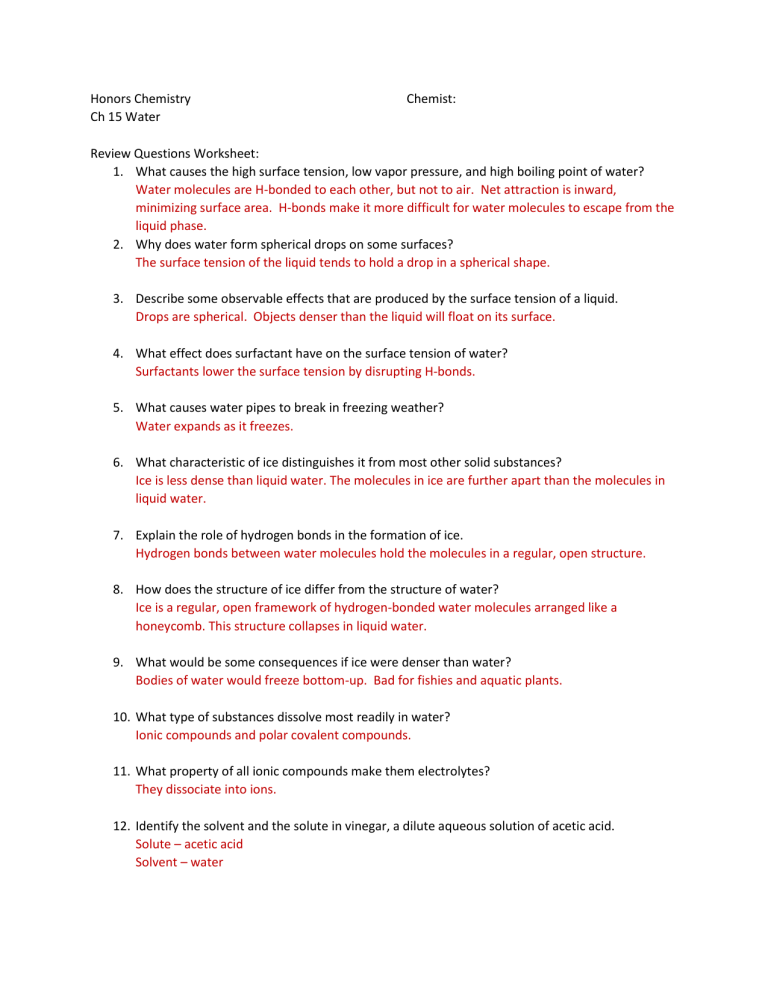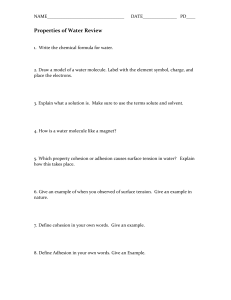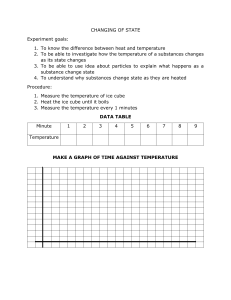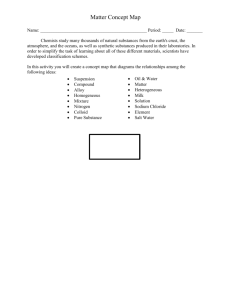
Honors Chemistry Ch 15 Water Chemist: Review Questions Worksheet: 1. What causes the high surface tension, low vapor pressure, and high boiling point of water? Water molecules are H-bonded to each other, but not to air. Net attraction is inward, minimizing surface area. H-bonds make it more difficult for water molecules to escape from the liquid phase. 2. Why does water form spherical drops on some surfaces? The surface tension of the liquid tends to hold a drop in a spherical shape. 3. Describe some observable effects that are produced by the surface tension of a liquid. Drops are spherical. Objects denser than the liquid will float on its surface. 4. What effect does surfactant have on the surface tension of water? Surfactants lower the surface tension by disrupting H-bonds. 5. What causes water pipes to break in freezing weather? Water expands as it freezes. 6. What characteristic of ice distinguishes it from most other solid substances? Ice is less dense than liquid water. The molecules in ice are further apart than the molecules in liquid water. 7. Explain the role of hydrogen bonds in the formation of ice. Hydrogen bonds between water molecules hold the molecules in a regular, open structure. 8. How does the structure of ice differ from the structure of water? Ice is a regular, open framework of hydrogen-bonded water molecules arranged like a honeycomb. This structure collapses in liquid water. 9. What would be some consequences if ice were denser than water? Bodies of water would freeze bottom-up. Bad for fishies and aquatic plants. 10. What type of substances dissolve most readily in water? Ionic compounds and polar covalent compounds. 11. What property of all ionic compounds make them electrolytes? They dissociate into ions. 12. Identify the solvent and the solute in vinegar, a dilute aqueous solution of acetic acid. Solute – acetic acid Solvent – water 13. Write the formulas for the following hydrates: a. Sodium sulfate decahydrate Na2SO4 •10H20 b. Calcium chloride dehydrate CaCl2 •2H20 c. Barium hydroxide octahydrate Ba(OH)2 •8H20 14. Name each hydrate: a. SnCl4 •5H20 Tin IV Chloride Pentahydrate b. FeSO4 •7H20 Iron II Sulfate Heptahydrate c. FePO4 •4H20 Iron III Phosphate Tetrahydrate 15. What is the percent by mass of water in Iron (II) Sulfate heptahydrate? 45.3% 16. Is the percent by mass of copper in CuSO4 •5H20 the same as in CuSO4? Explain. The percents of Cu in the two substances are different because the molar masses of the two compounds are different. 17. Distinguish between efflorescent and hygroscopic substances. Efflorescent compounds lose water to the air. Hygroscopic compounds remove moisture from the air. 18. Explain why hygroscopic substances can be used as a desiccant but a deliquescent substances cannot. Deliquescent compounds remove so much water from the air, the compound dissolves itself in the water. For example, if you are shipping a circuit board, a deliquescent that you’re attempting to use to keep it dry will inevitably cause the circuit board to get wet. 19. Which of the following substances dissolve to a significant extent in water? a. CH4 b. MgSO4 YES - ionic c. KCl YES - ionic d. sucrose – YES - polar d. I2 f. NaHCO3 YES -ionic 20. How does a suspension differ from a solution? The particles of a suspension are much larger and do not stay suspended indefinitely. 21. What distinguishes a colloid from a suspension and a solution? Colloids have particles smaller than those in a suspension but larger than those in a solution. 22. How can you determine through observation that a mixture is a suspension? Particles in a suspension will settle over time. 23. Could you separate a colloid through filtering? No. Particles in a colloid are smaller than the holes in the filter paper. 24. How can the Tyndall effect be used to distinguish between a colloid and a solution? A beam of light is visible as it passes through a colloid; a beam of light is invisible as it passes through a solution. 25. Can the presence of Brownian motion distinguish between a colloid and a solution? Explain. Yes. Scintillations are seen when colloids are studied under a microscope. Particles in a solution are too small to see with a microscope and do not cause scintillations. 26. From your knowledge of IMF’s, arrange these liquids in order of increasing surface tension: Water, hexane, ethanol. Hexane ethanol water 27. Explain which property of water is responsible for the following: a. Water in tiny cracks in the road turn into potholes in freezing temperatures. Water expands as it freezes into ice b. Water beads up on a newly waxed car. Water is polar and wax is nonpolar. Water also has a high surface tension. c. A teaspoon of water needs more time to evaporate compared to a teaspoon of alcohol. Water has a low vapor pressure due to H-bonds. 28. Match each term with the following description. a. Solution b. colloid c. suspension i. ii. iii. iv. v. vi. vii. viii. ix. Does not settle out upon standing a Heterogeneous b, c Particle size less than 1 nm a Particles can be filtered out c Demonstrates Tyndall effect b, c Particles are invisible to the unaided eye a, b Homogenized milk b Saltwater a Jelly b 29. When ethanol (C2H6O) dissolves in water, the volume of the final solution is less than the separate volumes of the water and alcohol added together. Can you explain this result? The h-bond structures in liquid water are disrupted when ethyl alcohol is added because the alcohol competes for hydrogen bonds with the water molecules and the water structure collapses. Thus, the volume will be less than the sum of the water and alcohol components. 30. You are given 3 white solids: A, B and c. You know one substance is glucose (C6H12O6), one must be potassium nitrate (KNO3), and one must be barium sulfate (BaSO4). Solid A dissolves in water and the resulting solution conducts an electric current. Solid B is insoluble. Solid C dissolves in water and does not conduct an electric current. Identify solids A,B, and C. A = potassium nitrate. B = barium sulfate. C = glucose.




